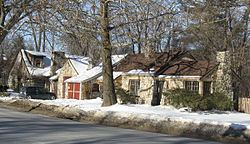Built 1939 Opened 1939 | NRHP Reference # 93000327 Added to NRHP 4 May 1993 | |
 | ||
Architect Moffitt, Howard Frances Architectural style Late 19th And 20th Century Revivals, English CottagePeriod House Similar Plum Grove Historic H, Old Brick Church, Iowa Old Capitol Building, Englert Theatre, Silos & Smokestacks National | ||
The Muscatine Avenue Moffitt Cottage Historic District is a National Register of Historic Places district that includes five stone cottages in Iowa City epitomizing the eccentric vernacular architectural style of Howard Moffitt. Moffitt constructed more than 100 houses in Iowa City and Coralville, Iowa and a few in Citrus City, Texas. These small houses represent one of the regional 20th century vernacular architectural styles in the United States. Howard Moffitt was a prolific builder.
Contents
Howard Moffitt
Howard Francis Moffitt was a prolific builder, constructing between 100 and 200 homes in Iowa City and Coralville between 1924 and 1943. With no formal training in construction or architecture, Moffitt began building homes as a side business from his auto parts distributorship. Moffitt's house designs appear to have been concocted from magazine photos, consultation with friends, limitations of available building supplies, and whimsy. In 1943 Moffitt moved to Citrus City, Texas, and attempted to reproduce his success there, however only seven or eight houses were built in Texas. Moffitt’s Iowa City houses appear to be a response to increasing demand for affordable small houses, especially rental houses, in the growing university town.
The Moffitt house style
No two Moffitt houses are identical. Moffitt’s building style was so eclectic that there are many homes in Iowa City in which there is no sure way to determine if Moffitt built them; his building records do not survive. "These mystical dwellings look as if Germanic elves constructed houses for Irish pixies", is how one writer described them. In general Moffitt houses borrow heavily from the English Cottage and American Craftsman styles of architecture, although there are examples of Moffitt building in styles reminiscent of southwestern stucco adobe and Prairie School styles. Several of his houses have concave or hipped roof. While there is no single architectural aspect that includes all Moffitt houses, there are some common design and decoration schemes that are commonly seen in Moffitt houses. These include:
